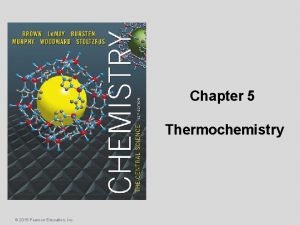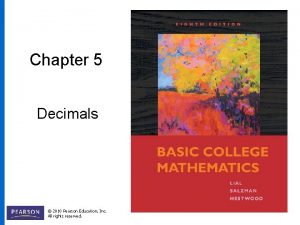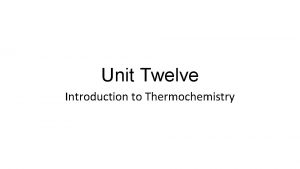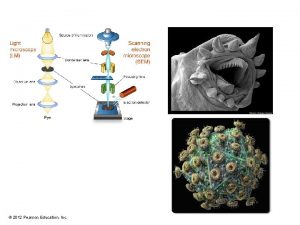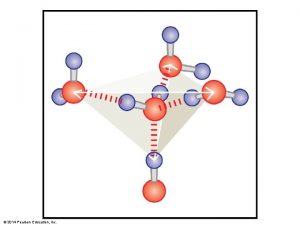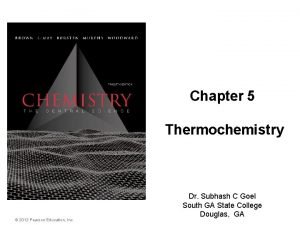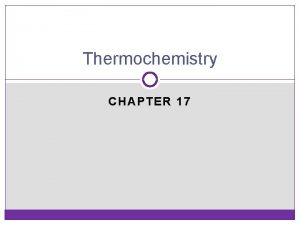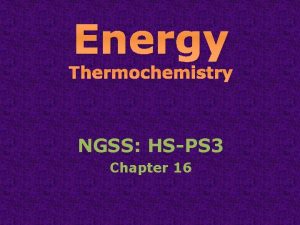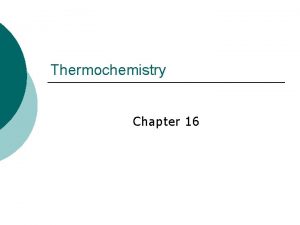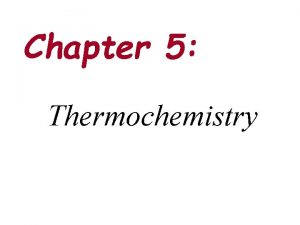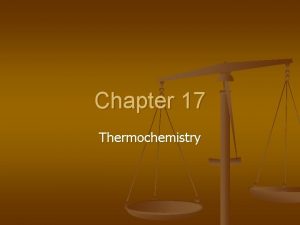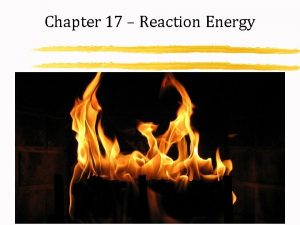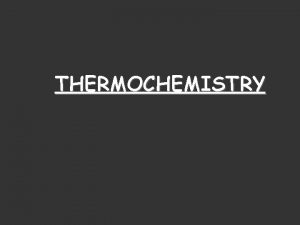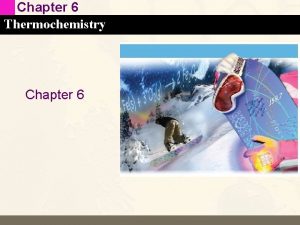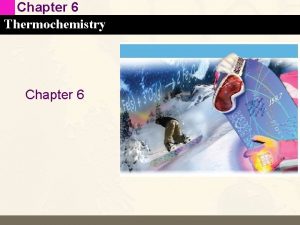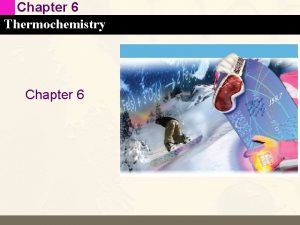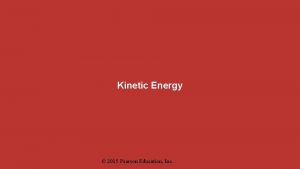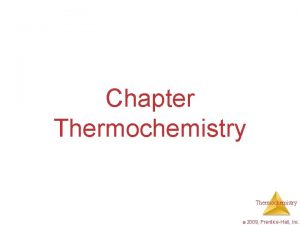Chapter 5 Thermochemistry 2015 Pearson Education Inc Energy













































- Slides: 45

Chapter 5 Thermochemistry © 2015 Pearson Education, Inc.

Energy • Energy is the ability to do work or transfer heat. – Energy used to cause an object that has mass to move is called work (W). – Energy used to cause the temperature of an object to rise is called heat (Q). • Thermodynamics – The study of energy transformations, and thermochemistry, which applies the field to chemical reactions, specifically. © 2015 Pearson Education, Inc.

Energy • Kinetic energy – Energy an object possesses by virtue of its motion • Potential energy – Energy an object possesses by virtue of its potential to do work. • (Gravitational potential energy) © 2015 Pearson Education, Inc.

Energy • Electrostatic potential energy • k = 8. 99 x 109 Jm/C 2 • Q = charge (C) • d = separation distance © 2015 Pearson Education, Inc.

Units of Energy • The SI unit of energy is the joule (J): • An older, non-SI unit is still in widespread use, the calorie (cal): 1 cal = 4. 184 J 1 kcal = 4184 J © 2015 Pearson Education, Inc.

System and Surroundings • The system – The molecules we want to study • The surroundings – Everything else © 2015 Pearson Education, Inc.

Transferring Energy: Work and Heat • Heat flows from warmer objects to cooler objects. © 2015 Pearson Education, Inc.

Calculating Energy Changes • What is the kinetic energy, in J, of a mole of Ar atoms moving at 650 m ⁄ s? (Hint: 1 amu = 1. 66 × 10− 27 kg. ) 1. Find the mass in kg 2. Solve for kinetic energy © 2015 Pearson Education, Inc.

First Law of Thermodynamics • “Energy is neither created nor destroyed, it is only transferred from one form to another. ” – The total energy of the universe is a constant; if the system loses energy, it must be gained by the surroundings, and vice versa. Thermodynamics © 2015 Pearson Education, Inc.

Internal Energy The internal energy of a system is the sum of all the energies of all components of the system; we call it E. © 2015 Pearson Education, Inc.

Internal Energy The change in internal energy is the final energy of the system minus the initial energy of the system: E = Efinal − Einitial © 2015 Pearson Education, Inc.

Internal Energy • Endergonic Reactions • Exergonic Reactions © 2015 Pearson Education, Inc.

Relating E to Heat and Work • When energy is exchanged between the system and the surroundings, it is exchanged as either heat (q) or work (w). © 2015 Pearson Education, Inc.

Endothermic and Exothermic Processes • Endothermic Reactions » System Gains Heat (From Where? ) • Exothermic Reactions » System Loses Heat © 2015 Pearson Education, Inc.

Calculating Heat and Work What is the change in the internal energy for a process in which a system absorbs 140 J of of heat from the surroundings and does 85 J of work on the surroundings? © 2015 Pearson Education, Inc.

State Functions • Internal energy is a state function. – It depends only on the present state of the system, not on the path by which the system arrived at that state. © 2015 Pearson Education, Inc.

State Functions • Q and W are not state functions. © 2015 Pearson Education, Inc.

Enthalpy • Enthalpy (H) – The internal energy plus the product of pressure and volume: © 2015 Pearson Education, Inc.

Pressure-Volume Work © 2015 Pearson Education, Inc.

Calculating Work What is the work done if the volume of a system contracts from 1. 55 L to 0. 85 L at a constant pressure of 0. 985 atm? © 2015 Pearson Education, Inc.

Calculating Work What is the work done if the volume of a system contracts from 1. 55 L to 0. 85 L at a constant pressure of 0. 985 atm? © 2015 Pearson Education, Inc.

Enthalpy Change • Endothermic = + H • Exothermic = - H © 2015 Pearson Education, Inc.

Enthalpy Change Usually in an open container the only work done is by a gas pushing on the surroundings (or by the surroundings pushing on the gas). © 2015 Pearson Education, Inc.

Enthalpies of Reaction • The change in enthalpy, H, is the enthalpy of the products minus the enthalpy of the reactants: • In the reverse reaction H is the opposite sign © 2015 Pearson Education, Inc.

Calculating Enthalpies of Reaction • Hydrogen peroxide decomposes to water and oxygen. • Calculate the quantity of heat released when 5. 00 g of H 2 O 2 decomposes at constant pressure. © 2015 Pearson Education, Inc.

Calorimetry • Since we cannot know the exact enthalpy of the reactants and products, we measure H through calorimetry, the measurement of heat flow. © 2015 Pearson Education, Inc.

Heat Capacity and Specific Heat • The amount of energy required to raise the temperature of a substance by 1 K (1 C) is its heat capacity • The amount of energy required to raise the temperature of 1 g of a substance by 1 K (or 1 C) is its specific heat capacity (or simply specific heat) © 2015 Pearson Education, Inc.

Heat Capacity and Specific Heat © 2015 Pearson Education, Inc.

Calculating Specific Heat • Large beds of rocks are used in some solar-heated homes to store heat. The specific heat of the rocks is 0. 82 J/g*K. What is the heat absorbed by 50. 0 kg of the rocks if their temperature increases by 12. 0 o. C? © 2015 Pearson Education, Inc.

Calculating Specific Heat • Large beds of rocks are used in some solar-heated homes to store heat. The specific heat of the rocks is 0. 82 J/g*K. What temperature change would these rocks undergo if they emitted 450 k. J of heat? © 2015 Pearson Education, Inc.

Constant Pressure Calorimetry • By carrying out a reaction in aqueous solution in a simple calorimeter, the heat change for the system can be found by measuring the heat change for the water in the calorimeter. • The specific heat for water is well known (4. 184 J/g∙K). • We can calculate H for the reaction with this equation: q = m Cs T © 2015 Pearson Education, Inc.

Calculating Specific Heat • When 50. 0 m. L of 0. 100 M Ag. NO 3 and 50 m. L of 0. 100 M HCl are mixed in a calorimeter the temperature of the mixture increases from 22. 30 to 23. 11 o. C. • Calculate H for this reaction in k. J/mol Ag. NO 3 assuming the combined solution has a mass of 100. 0 g. © 2015 Pearson Education, Inc.

Calculating Specific Heat • When 50. 0 m. L of 0. 100 M Ag. NO 3 and 50 m. L of 0. 100 M HCl are mixed in a calorimeter the temperature of the mixture increases from 22. 30 to 23. 11 o. C. • Calculate H for this reaction in k. J/mol Ag. NO 3 assuming the combined solution has a mass of 100. 0 g. © 2015 Pearson Education, Inc.

Constant Volume Calorimetry • Reactions can be carried out in a sealed “bomb” such as this one. • The heat absorbed (or released) by the water is a very good approximation of the enthalpy change for the reaction. © 2015 Pearson Education, Inc.

Hess’s Law • If a reaction is carried out in a series of steps, H for the overall reaction will be equal to the sum of the enthalpy changes for the individual steps. • Because H is a state function, the total enthalpy change depends only on the initial state (reactants) and the final state (products) of the reaction. Hess's Law © 2015 Pearson Education, Inc.

Hess’s Law • The enthalpy of reaction for the combustion of C to CO 2 is − 393. 5 k. J ⁄ mol C, and the enthalpy for the combustion of CO to CO 2 is − 283. 0 k. J ⁄ mol CO: C(s) + O 2(g) → CO 2(g) ΔH = − 393. 5 k. J CO(g) + O 2(g) → CO 2(g) ΔH = − 283. 0 k. J Using these data, calculate the enthalpy for the combustion of C to CO: C(s) + O 2(g) → CO(g) ΔH = ? © 2015 Pearson Education, Inc.

Hess’s Law C(s) + O 2(g) → CO 2(g) ΔH = − 393. 5 k. J CO(g) + ½ O 2(g) CO 2(g) ΔH = +283. 0 k. J (-393. 5 k. J) + (+283. 0 k. J) = -110. 5 k. J C(s) + ½ O 2(g) → CO(g) ΔH = -110. 5 k. J © 2015 Pearson Education, Inc.

Hess’s Law Calculate ΔH for: 2 NO(g) + O 2(g) → N 2 O 4(g) → 2 NO 2(g) 2 NO(g) + O 2(g) → 2 NO 2(g) © 2015 Pearson Education, Inc. ΔH = +57. 9 k. J ΔH = − 113. 1 k. J

Hess’s Law Calculate ΔH for: 2 NO(g) + O 2(g) → N 2 O 4(g) 2 NO(g) + O 2(g) → 2 NO 2(g) N 2 O 4(g) 2 NO 2(g) ΔH = − 113. 1 k. J ΔH = -57. 9 k. J ΔH = − 171. 0 k. J © 2015 Pearson Education, Inc.

Hess’s Law • Carbon occurs in two forms, graphite and diamond. The enthalpy of the combustion of graphite is − 393. 5 k. J ⁄ mol, and that of diamond is − 395. 4 k. J ⁄ mol: C(graphite) + O 2(g) → CO 2(g) ΔH = − 393. 5 k. J C(diamond) + O 2(g) → CO 2(g) ΔH = − 395. 4 k. J • Calculate ΔH for the conversion of graphite to diamond: C(graphite) → C(diamond) © 2015 Pearson Education, Inc.

Hess’s Law C(graphite) + O 2(g) → CO 2(g) ΔH = − 393. 5 k. J C(diamond) + O 2(g) → CO 2(g) ΔH = − 395. 4 k. J • Calculate ΔH for the conversion of graphite to diamond: C(graphite) + O 2(g) → CO 2(g) C(diamond) + O 2(g) CO 2(g) © 2015 Pearson Education, Inc. ΔH = − 393. 5 k. J ΔH = +395. 4 k. J ΔH = +1. 9 k. J

Enthalpies of Formation An enthalpy of formation, Hf, is defined as the enthalpy change for the reaction in which a compound is made from its constituent elements in their elemental forms. Enthalpy of Formation © 2015 Pearson Education, Inc. At STP

Calculation of H using Values from the Standard Enthalpy Table C 3 H 8(g) + 5 O 2(g) 3 CO 2(g) + 4 H 2 O(l) C 3 H 8= -103. 85 k. J/mol CO 2 = -393. 5 k. J/mol H 2 O = -285. 8 k. J/mol O 2 = 0 final initial H = [3(CO 2) + 4(H 2 O)] – [1(C 3 H 8) + 5(O 2)] H = [3(− 393. 5 k. J) + 4(− 285. 8 k. J)] – [1(− 103. 85 k. J) + 5(0 k. J)] = [(− 1180. 5 k. J) + (− 1143. 2 k. J)] – [(− 103. 85 k. J) + (0 k. J)] = (− 2323. 7 k. J) – (− 103. 85 k. J) = − 2219. 9 k. J © 2015 Pearson Education, Inc.

Energy in Foods and Fuels Most of the fuel in the food we eat comes from carbohydrates and fats. © 2015 Pearson Education, Inc.

Energy in Foods and Fuels Fuel Value from Food Dry red beans contain 62% carbohydrate, 22% protein, and 1. 5% fat. Estimate the fuel value of these beans. Carbs = 17 k. J/g x 0. 62 = 10. 54 k. J/g Protein = 17 k. J/g x 0. 22 = 3. 74 k. J/g Fat = 38 k. J/g x 0. 015 = 0. 57 k. J/g © 2015 Pearson Education, Inc.
 2015 pearson education inc
2015 pearson education inc Copyright pearson education inc
Copyright pearson education inc 2015 pearson education inc
2015 pearson education inc 2015 pearson education inc
2015 pearson education inc 2015 pearson education inc
2015 pearson education inc 2015 pearson education inc
2015 pearson education inc 2015 pearson education inc
2015 pearson education inc 2015 pearson education inc
2015 pearson education inc Pearson education inc publishing
Pearson education inc publishing 2015 pearson education inc
2015 pearson education inc Pearson education inc. publishing as prentice hall
Pearson education inc. publishing as prentice hall Pearson education inc publishing as pearson prentice hall
Pearson education inc publishing as pearson prentice hall Pearson education inc publishing as pearson prentice hall
Pearson education inc publishing as pearson prentice hall Pearson education inc. 2012
Pearson education inc. 2012 Copyright 2008
Copyright 2008 Pearson education limited 2015
Pearson education limited 2015 Foundations of planning
Foundations of planning Pearson education limited 2015
Pearson education limited 2015 Pearson education limited 2015
Pearson education limited 2015 Pearson education limited 2015
Pearson education limited 2015 Pearson education limited 2015
Pearson education limited 2015 Pearson education limited 2015
Pearson education limited 2015 Pearson education limited 2015
Pearson education limited 2015 Pearson education limited 2015
Pearson education limited 2015 Copyright pearson education inc
Copyright pearson education inc 2017 pearson education inc
2017 pearson education inc 2017 pearson education inc
2017 pearson education inc 2017 pearson education inc
2017 pearson education inc 2017 pearson education inc
2017 pearson education inc 2017 pearson education inc
2017 pearson education inc 2017 pearson education inc
2017 pearson education inc 2016 pearson education inc
2016 pearson education inc 2014 pearson education inc
2014 pearson education inc 2013 pearson education inc
2013 pearson education inc 2013 pearson education inc
2013 pearson education inc 2013 pearson education inc
2013 pearson education inc 2013 pearson education inc
2013 pearson education inc Pearson education inc. 2012
Pearson education inc. 2012 2012 pearson education inc
2012 pearson education inc Pearson education inc. 2012
Pearson education inc. 2012 2010 pearson education inc
2010 pearson education inc Copyright 2010 pearson education inc
Copyright 2010 pearson education inc 2009 pearson education inc
2009 pearson education inc 2016 pearson education inc
2016 pearson education inc 2010 pearson education inc answers
2010 pearson education inc answers 2010 pearson education inc answers
2010 pearson education inc answers









